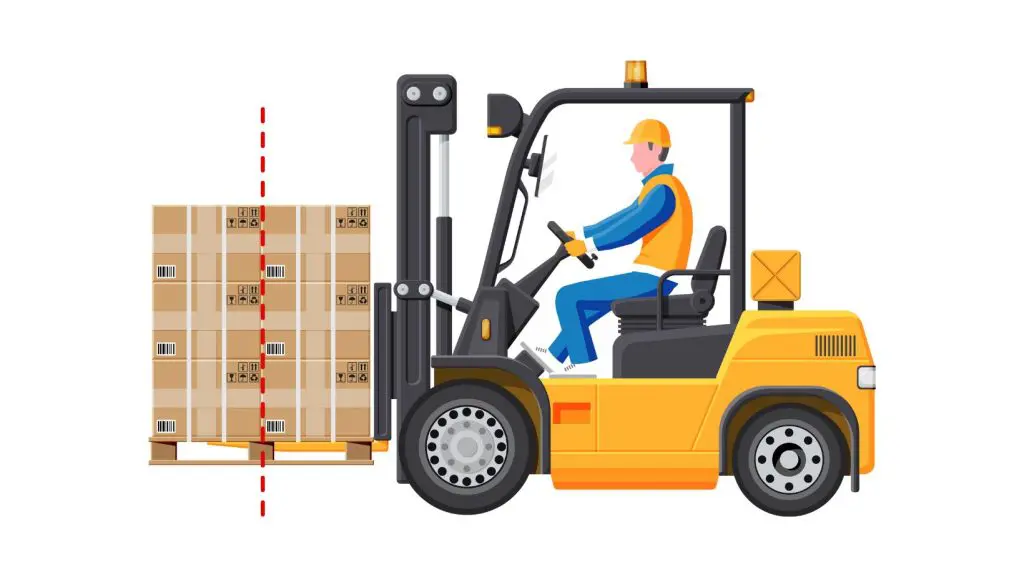
Forklifts are invaluable tools for many industries, allowing the efficient movement and safe handling of heavy goods. However, effectively operating a forklift comes from thoroughly understanding its components and dynamics. The load centre is a critical element significantly impacting forklift performance and stability. If you are wondering what a forklift load centre is, you are in the right place. Our comprehensive blog will delve into defining a load centre and how you can calculate your forklift load centre to ensure safe and efficient operation.
- How Do Forklifts Work?
- What is a Forklift Load Centre?
- How to Work Out a Forklift Load Centre
- What Factors Influence the Load Centre?
- Load Centre Tips & Tricks
- Fork Load Centre FAQs
How Do Forklifts Work?
Before determining the load centre of a forklift, we need to understand how a forklift works. The composition of a forklift means it acts similarly to a seesaw. If one side has more weight than the other, your truck is at risk of tipping over. The forklift, therefore, needs to be loaded correctly to ensure a safe operation.
What is a Forklift Load Centre?
A forklift load centre is the distance between the forks’ vertical face and the load’s centre of gravity.
Essentially, the load centre is the middle of a forklift load. The centre of gravity is the point where an item’s weight is concentrated, which exists individually in the forklift and a load. In an unloaded forklift, the centre of gravity falls towards the rear of the machine.
The arrangement of the items in a load determines the centre of gravity. Once the forklift is loaded, the centre of gravity combines with the load and moves toward the front of the machine to prevent tipping. Therefore, it is essential to determine the load centre of your forklift to keep the centre of gravity in the middle.
How to Work Out a Forklift Load Centre
The majority of standard forklift trucks handle 1 metre long pallets. Assuming the load is evenly distributed when placed on the forklift, it will have a 61 centimetre load centre. All forklifts contain a rating plate detailing maximum weight capacity at a certain height and the load centre distance to ensure safe operation.
However, it is essential to remember that the load centre is not always 61 centimetres. The load centre will change depending on the length of the load they are handling. Forklifts designed to lift long loads may have a 91 centimetre load centre but could be as high as 121 centimetres.
Calculating Load Capacity
Knowing your forklift load centre is essential for determining its lifting capacity. Forklift lift capacity measures how much weight a forklift can safely carry. A safe load capacity must be calculated to ensure a secure operation, especially if the load is oversized.
If we assume that a forklift has a 61 centimetre standard load centre with a rated capacity of 1.81 kilograms, but we need to handle a load with a load centre of 81 centimetres, a safe load capacity for your forklift would be less than 1.81 kilograms.
To calculate the safe load capacity, take the standard load capacity and divide it by the actual load centre of your load. Multiply this figure by the rated capacity to retrieve your answer, for example:
(61 cm / 81cm) * 1.81kg = 1.37kg
Your forklift, therefore, has a safe load capacity of 1.37 kilograms for a load centre of 81 centimetres.
What Factors Influence the Load Centre?
Attachments
Installing any after market forklift attachments, such as fork rotators and side shift, will increase the load centre as they change the distance from the original fork face and the fulcrum point. The distance the attachment extends the load centre forward is the effective thickness. This, in turn, causes the load moment to increase, consequently decreasing the lifting capacity. Forklifts with attachments added should install a new data plate outlining the new load centre distance.
Load Distribution
The load centre is only applicable to loads that are evenly distributed. The centre of gravity for an unevenly distributed load will either move forward or side-to-side, causing the lifting capacity to decrease. In cases where the load centre is uneven, forklift operators should keep the load as close to the ground as possible during transportation.
Load Centre Tips & Tricks
Our top 4 tips and tricks to maintain your forklift load centre:
- Distribute your load evenly if possible
Uneven loads will increase the load centre. If the centre of gravity does not sit in the middle of the forklift once loaded, it is at risk of tipping over. Arrange your load evenly in vertical and horizontal directions to maintain the centre of gravity.
- Load items as close to the fork face as possible
Ensure the load is placed on the forks and as close to the load backrest as possible. The load centre increases with the distance the load is placed away from the backrest. This reduces lifting capacity, so it is best practice to ensure it is against the backrest.
- Forward tilting reduces truck stability
If your forklift is loaded, tilting the load forward will increase the load centre. This is because you are moving the load away from the middle of the forklift, offsetting the centre of gravity. If you are handling a load that is already pushing the safe load capacity, tilting forward can cause the forklift to tip forward, resulting in injury.
- Drive carefully
Even if your load is evenly distributed and within its safe loading capacity, the truck can become unstable if not driven carefully. Driving at a sensible speed, below the recommended speed limit, is essential. Accelerate and brake smoothly, slowing down for any corners while keeping the load as low to the ground as safely possible.
Fork Load Centre FAQs
How far should forks enter a pallet?
The forks should be placed under a load as far as possible. The forks should be at least two-thirds the length of the load for safe operation.
Can a forklift be unstable without a load?
Forklifts can become unstable even without carrying a load if not carefully driven. If a driver turns a corner too fast or travels over an uneven surface, they risk tipping over and injuring themselves or those around them.
What would happen if you exceeded the safe load capacity?
It is an offence to exceed the truck’s capacity, in line with the LOLER 1998 and Health and Safety at Work Act Section 7a, Acts and Omissions. By overloading your forklift, you are throwing the centre of gravity off, increasing the likelihood of tipping. This is extremely dangerous. Tip-overs are the leading cause of forklift injuries and casualties a year, so it is crucial to avoid exceeding the safe loading capacity of your forklift.
Progress Your Forklift Skillset with HL Training
Expand your forklift knowledge and learn the ins and outs of operation with our extensive range of expert training courses at HL training. At HL Training, we proudly deliver both off-site and in-house accredited training designed to suit your requirements. Whether you are a novice hoping to learn the ropes of forklift operation or an experienced forklift operator wanting to become an instructor, we have the perfect array of training courses. Contact our expert team today to learn more about our services.





